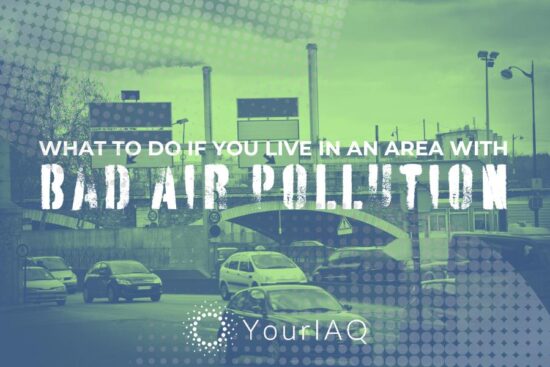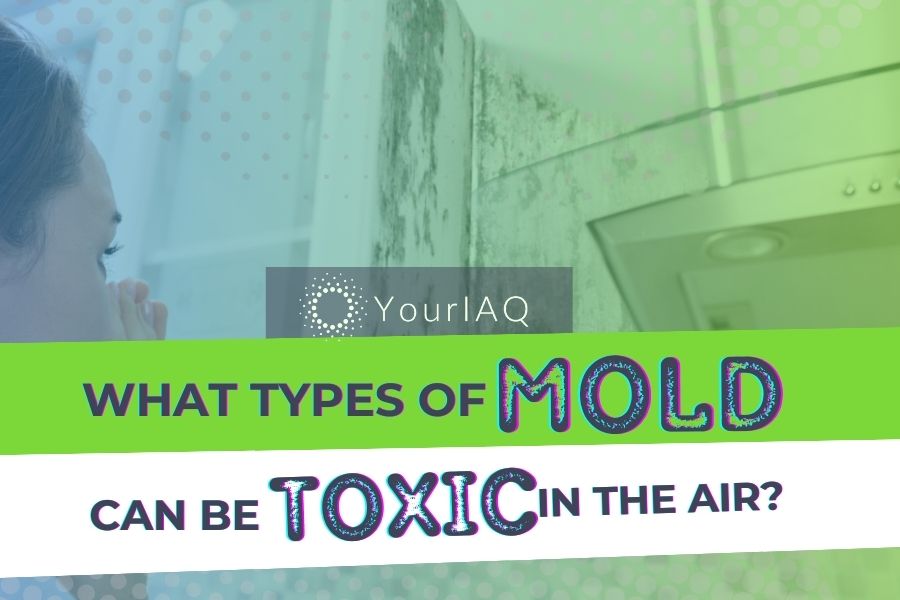
It’s a question worth asking because the mold growing in your home could be more than just an eyesore. The next breath you take might contain toxins from unseen mold lurking in your home. Recent studies reveal that some types of toxic mold release harmful toxins directly into the air, even without being disturbed. These toxins trigger allergies, exacerbate respiratory problems, and even lead to severe health conditions such as asthma or lung infections.
Don’t take chances—in this article, we’ll identify the most common types of household mold, explain how they affect your health, and give you the tools to spot them before they become a problem.
Toxic Indoor Molds: Common Types and Their Dangers
Let’s get into the usual suspects lurking in homes and the trouble they can cause. Remember, this isn’t an exhaustive list, but it covers the types you’re most likely to encounter:
1. Stachybotrys chartarum – How Black Mold Makes Indoor Air Toxic
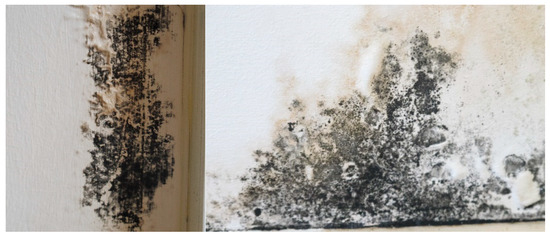
Black molds produce mycotoxins which are harmful to both animals and humans
Stachybotrys chartarum spreads by releasing microscopic spores, which are irritating (especially if you have allergies), but they’re not the most dangerous part. Some—but not all—types of black mold produce mycotoxins to protect themselves and compete for resources in their environment.
| What type of mycotoxin do black molds produce?
Black mold produces two types of mycotoxins, but only one of them is considered particularly toxic. This toxin falls within a larger family of chemically related compounds called trichothecenes. Within this group, black mold specifically produces macrocyclic trichothecenes, including:
The trichothecene mycotoxins produced by black mold disrupt how cells function, eventually causing them to die. This makes them particularly harmful and is a major reason why black mold exposure is so dangerous. |
Health effects of black molds
Toxins from black molds irritate the lungs and even enter the bloodstream if inhaled. They cause a range of problems, from irritated lungs to more serious issues with prolonged or heavy exposure. The specific health effects of black mold toxins exposure vary depending on the type and amount inhaled, but potential problems include:
- Respiratory issues: Coughing, wheezing, shortness of breath, worsening of asthma symptoms
- Allergic reactions: Runny nose, itchy eyes, skin irritation
- Neurological problems: Headaches, fatigue, difficulty concentrating
- Severe cases: Black mold poisoning
Who’s Most at Risk: Those with allergies, asthma, or any compromised immune system are particularly vulnerable. Exposure is dangerous for vulnerable populations (infants, young children, and the elderly).
Sources of black molds
S. chartarum or black molds isn’t picky, but it loves chronically damp materials. This includes water-damaged drywall, wood, ceiling tiles, insulation, attics, and under carpets—often in places with leaks or lingering moisture issues, which makes detection difficult. By the time you notice visible mold growth, you may have been breathing in mycotoxins for some time.
Important note:
While the greenish-black, slimy appearance is classic, not all black mold is Stachbotrys chartarum. TESTING is the only way to confirm the type.
Black mold gets a lot of attention, but it’s not the only mold that poses a toxic risk to your indoor air. Let’s look at a few other common culprits.
2. Aspergillus – A Common Culprit in Mold-Related Health Issues
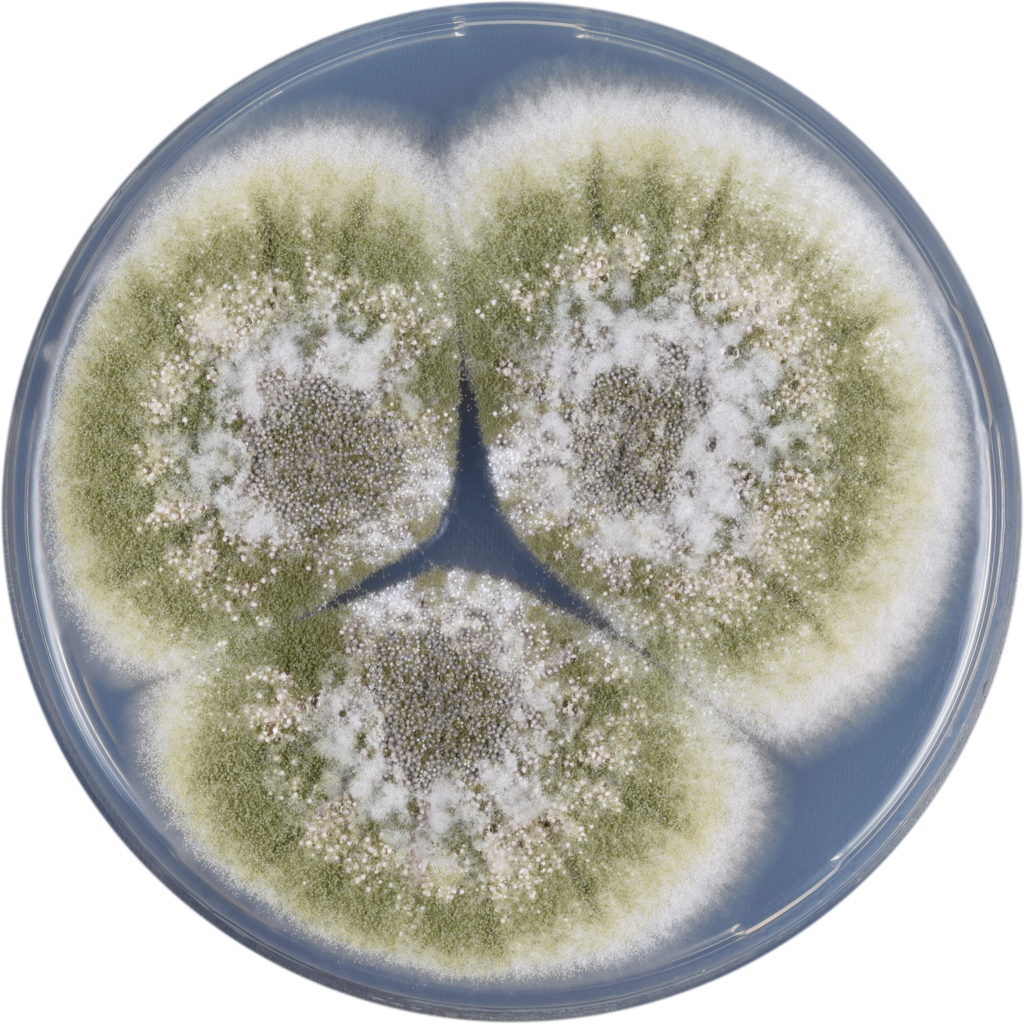
Here’s a closer look at how Aspergillus impacts indoor air quality and health:
How Aspergillus spreads (and where it thrives)
Aspergillus spores float through the air, easily entering homes through
- Open doors and windows
- HVAC systems (air conditioning, poorly maintained ducts)
Once inside, they seek out warm, damp places like:
- Bathrooms
- Kitchens
- Areas with water damage or leaks
- Air conditioning systems
Their versatility means they grow on a variety of surfaces, including food (mostly on potatoes and bread). This makes them a concern for both health and food safety.
Some Aspergillus species produce aflatoxins, which are known to cause cancer
Certain Aspergillus species, such as A. flavus, A. parasiticus, and A. nomius, produce potent mycotoxins, including aflatoxins, which are considered highly carcinogenic (cancer-causing). While not all Aspergillus species are harmful, those that produce mycotoxins severely impact health.
Mycotoxins from Aspergillus can cause a range of health issues, from allergic reactions and respiratory problems to more severe conditions like aspergillosis—a spectrum of diseases caused by Aspergillus infection.
The risk is particularly high for individuals with compromised immune systems or pre-existing lung conditions. Even those without health conditions can experience respiratory problems with prolonged exposure.
How to identify Aspergillus in your home
Aspergillus comes in a rainbow of colors (green, yellow, brown, etc.) and has a velvety or dusty texture. While some are easily visible, others might be hidden within HVAC systems or damp areas.
Pro-tip: Regular home inspections and proper ventilation system maintenance are key to identifying and controlling Aspergillus growth. Good ventilation and controlling moisture are essential to keep this mold at bay.
3. Penicillium – A Friend or An Indoor Foe?
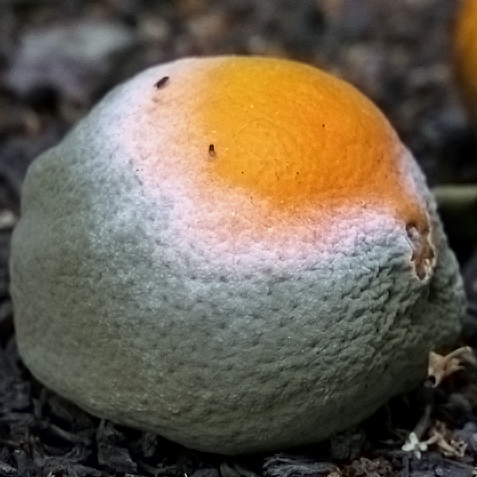
Here’s an in-depth look at Penicillium’s characteristics, potential health impacts, and common sources in homes.
Penicillium’s signature appearance
Penicillium molds, easily recognizable by their blue or green coloration and velvety texture, can spread rapidly across surfaces. This includes food and damp building materials, where the widespread Penicillium chrysogenum species thrives. In fact, P. chrysogenum is commonly found in house dust, indoor air, and water-damaged environments.
This mold’s ability to spread and persist indoors is due to its production of numerous tiny spores. These spores, measuring only 3 to 5 micrometers, are produced in dry chains, making them easily airborne.
Their small size allows them to remain suspended in the air for long periods and be inhaled deeply into the lungs. This makes Penicillium a year-round concern in indoor environments.
Common sources and habitats in the home
Penicillium thrive in environments where moisture is abundant. It commonly grows on materials that have been damaged by water—wallpapers, carpets, and insulation materials are particularly susceptible. The spores of Penicillium also circulate through the air, especially in homes with poor ventilation, making it a common occupant of air ducts and HVAC systems.
Penicillium verrucosum produces Ochratoxin A, which can damage kidneys
While Penicillium is famed for producing penicillin, a lifesaving antibiotic, certain species produce mycotoxins that are harmful to humans and animals. One of the most concerning is Ochratoxin A (OTA), which can damage the kidneys and is linked to other health problems with prolonged exposure.
Exposure to Penicillium spores, especially in sensitive individuals, leads to allergic reactions, including symptoms such as:
- sneezing
- coughing, and
- eye irritation
In more severe cases, prolonged exposure to mycotoxins leads to respiratory issues and may affect the immune system.
When to be concerned: The appearance of Penicillium on household surfaces is a clear sign that moisture levels may be too high, and action should be taken to address the underlying causes.
4. Fusarium – A Colorful Threat to Your Health
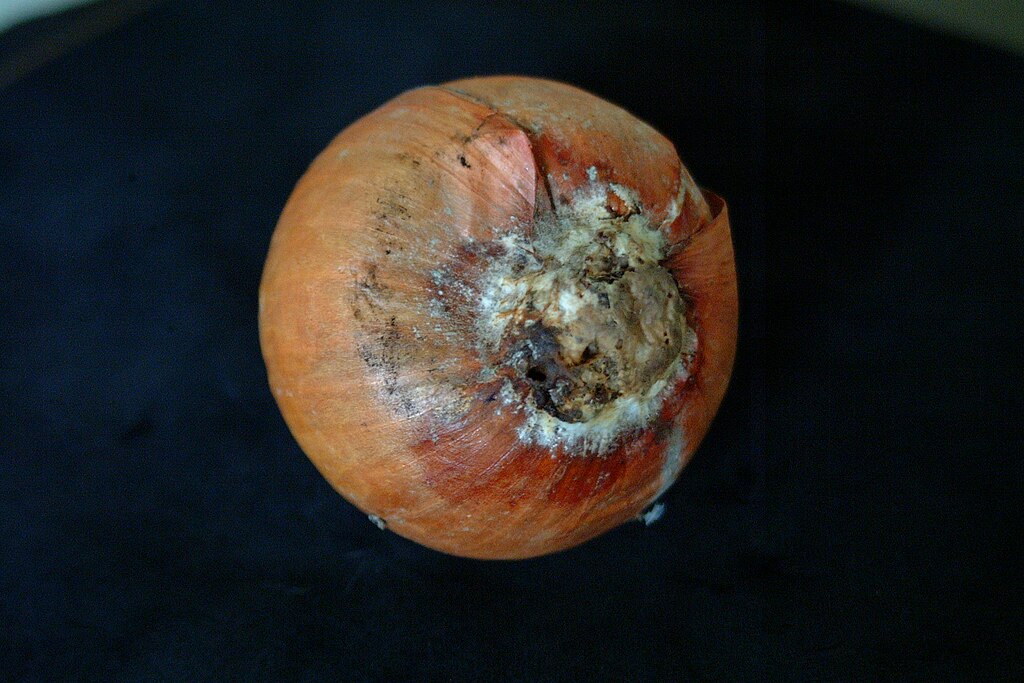
Let’s explore the appearance, toxicity, and common sources of Fusarium in indoor settings.
What does Fusarium look like
Fusarium molds can exhibit a range of colors, including pink, white, and reddish hues, that catch the eye when they appear on indoor surfaces. Their growth often results in a fluffy or cotton-like texture, making them somewhat less discreet than molds like Cladosporium.
Where to find Fusarium
- From the Outdoors: Fusarium naturally lives in soil and on plants. It can hitch a ride indoors on:
- Shoes
- Pets
- Plant materials (cut flowers, houseplants, etc.)
- HVAC Systems: Once inside, Fusarium spores easily spread through your home’s ventilation system.
- Water-damaged fabrics: Found also on carpets and other fabrics with excessive moisture
Fusarium releases deoxynivalenol (DON) mycotoxins that cause digestive problems
Fusarium releases harmful mycotoxins that affect both humans and animals. One particularly concerning mycotoxin is deoxynivalenol (DON), which is known to cause digestive problems like vomiting, diarrhea, and abdominal pain. Long-term exposure is linked to weakened immune function and other health issues.
The primary routes of exposure to Fusarium mycotoxins in indoor environments are inhalation of spore-laden air and contact with contaminated surfaces. The risk is particularly pronounced in damp areas where Fusarium can thrive unchecked.
Who’s Most at Risk: People with weakened immune systems, chronic health issues, and the very young or elderly need to be particularly cautious.
Dealing with Fusarium contamination
For small patches of Fusarium on non-porous surfaces, careful DIY removal might be possible. However, take strict precautions, including protective gear, as Fusarium toxins are harmful. Large infestations, contamination of porous materials like drywall or carpets, or any health concerns within your household necessitate professional mold remediation.
These specialists have the expertise and equipment to safely remove the mold and, importantly, address the underlying moisture source that allowed it to thrive, preventing a recurrence.
5. Cladosporium – A Common Trigger for Respiratory Troubles
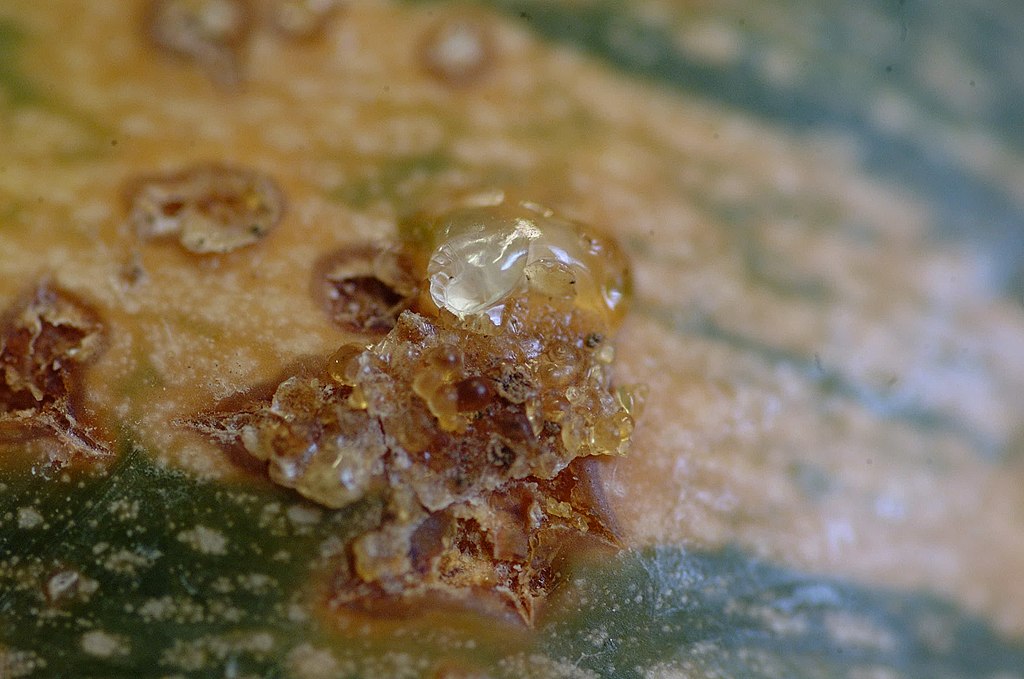
Here’s a closer look at how Cladosporium enters our homes, what it looks like, its health implications, and effective strategies for its management.
How to identify Cladosporium
Cladosporium typically makes its presence known by appearing as a black or green “pepper-like” substance on surfaces. This mold has a penchant for textiles, wood, and other porous materials, where it not only grows but thrives. It often creates a patchy appearance that can be mistaken for simple dust or dirt.
Where Cladosporium hides:
This mold thrives in damp environments, so check:
- Wood (especially if it’s been water-damaged)
- Fabrics (curtains, upholstery, etc.)
- Areas around air conditioning units or poorly maintained HVAC systems
Health effects of Cladosporium exposure
Cladosporium is primarily an allergy and respiratory irritant. It can trigger reactions. The severity of reactions to Cladosporium varies based on individual sensitivity. Potential issues include:
- Sneezing, runny nose, itchy eyes
- Coughing, wheezing, difficulty breathing
- Worsening of asthma or sinus problems
- In rare cases, severe allergic reactions or lung infections in those with severely compromised health
Who’s Most at Risk: Those with allergies, asthma, compromised immune systems, or chronic sinus problems.
Other Problematic Molds to Watch Out For
6. Alternaria
Alternaria is a significant contributor to allergies and worsens pre-existing conditions like asthma and hay fever. It thrives in damp environments, including bathrooms, kitchens, and around leaky windows or poorly ventilated areas. This mold spreads easily through airborne spores, making it a persistent indoor air quality problem.
7. Trichoderma
Usually greenish with a musty odor, these molds favor damp fabrics and decaying wood. They’re linked to allergy symptoms and, more rarely, infections.
8. Chaetomium
Often found on damp drywall and cellulose-based materials (like paper). It produces mycotoxins in some species, causing allergy-like symptoms and skin or nail infections in rare cases.
9. Ulocladium
Ulocladium, a dark-colored mold thriving in very wet conditions, causes allergies (sneezing, runny nose, itchy eyes, and coughing) and respiratory problems, especially in those with existing sensitivities. Its presence often signals a serious moisture problem within your home, making prompt action necessary to protect both your health and your house’s structure.
10. Acremonium
Acremonium molds grow slowly and appear in various colors. While some species are relatively harmless, others produce toxins that contribute to various health problems. These health concerns range from allergies to more serious conditions with prolonged exposure.
See also: The Threatening 13: Most Common Indoor Air Pollutants According to the EPA
Toxic Molds at a Glance
Understanding the types of mold in your home is crucial for protecting your health. Here’s a guide to the most common culprits and their dangers:
| Mold Type | Category | Main Health Effects | Where it Thrives |
| Stachybotrys Chartarum (Black Mold) | Toxigenic | Allergies, respiratory issues, neurological problems (in severe cases) | Chronically damp materials (drywall, wood, insulation), often hidden behind walls or in spaces with leaks |
| Aspergillus | Allergenic, Pathogenic, or Toxigenic* | Allergies, respiratory issues, cancer risk (from certain types), aspergillosis (in severe cases) | Warm, damp places (bathrooms, kitchens, HVAC systems), can also contaminate food |
| Penicillium | Allergenic or Toxigenic* | Allergies, respiratory issues, kidney damage risk (from certain types) | Damp materials (wallpaper, carpet), surfaces with poor ventilation, can be found on food |
| Fusarium | Toxigenic | Digestive problems, weakened immune function (with prolonged exposure) | Damp materials (especially fabrics), brought in from outdoors (plants, soil, etc.) |
| Cladosporium | Allergenic | Primarily an allergy and respiratory irritant | Damp wood, fabrics, areas around AC units or poorly maintained HVAC systems |
| Alternaria | Allergenic | Significant allergy trigger, asthma, and hay fever | Damp areas (spreads easily) |
| Trichoderma | Allergenic | Allergies, infections (rare cases) | Damp fabrics, decaying wood |
| Chaetomium | Allergenic | Allergies, skin/nail infections (rare cases) | Damp drywall, cellulose-based materials (paper) |
| Ulocladium | Allergenic | Allergies, respiratory issues | Very wet conditions |
| Acremonium | Toxigenic | Allergies, some toxigenic species | Various colors, slow-growing |
*Aspergillus & Penicillium: The category depends on the specific species within the large Aspergillus and Penicillium families. Some are harmless, while others are dangerous.
Keeping Mold Out of Your Home
The best way to avoid the health problems caused by toxic molds is to prevent them from growing in the first place. Here’s how:
- Fix leaks promptly in your roof, plumbing, and around windows and doors.
- Exhaust fans should be used in the bathroom and kitchen during and after use.
- Run a dehumidifier in chronically damp areas, and empty it regularly.
- Dry any water spills or wetness within 24-48 hours to prevent mold growth.
- Regularly clean showers, bathtubs, and sinks to prevent mildew buildup.
- Dry areas around air conditioners where condensation can form.
- Make sure your HVAC system is cleaned and maintained properly.
- Consider an air purifier with a HEPA filter in areas where mold is a concern.
If you see mold: Don’t ignore it! Promptly address any mold growth you find, especially if it looks like one of the types discussed in this article. Small amounts might be manageable to clean yourself, but for larger areas or suspected toxic molds, professional remediation is often necessary.
Check out these resources for more information:
When to Get Professional Help
While some small mold issues can be handled with DIY methods, there are times when calling in a professional is essential:
- Big Patches: If the mold covers a significant area (more than a few square feet), it’s best to call specialists. They have the equipment and expertise to remove large infestations safely.
- Unknown Mold: If you can’t identify the type of mold or suspect it might be one of the more toxic varieties we’ve discussed, it’s wise to get a professional assessment.
- Health Concerns: If you’re experiencing unexplained respiratory problems, allergies, or other symptoms that might be mold-related, see a doctor. If you have a compromised immune system, children, or the elderly in your home, take extra precautions and consult a remediation specialist.
Conclusion
Understanding the dangers posed by toxic molds in your home is the first step in an ongoing effort. Proactive moisture control, swift response to any visible mold, and awareness of potential health risks are essential for consistently protecting your indoor air quality and the health of your household.
Protect your health and the well-being of those you live with – take mold seriously.
Frequent Asked Questions
How can you tell if mold is toxic?
You can’t definitively tell by looks alone. Visual identification is unreliable, as even harmless molds resemble toxic ones. Professional testing (DIY kits or lab analysis) is the most reliable way to know for sure.
What type of mold is not toxic?
Many mold types are harmless under normal circumstances. However, even ‘non-toxic’ molds trigger allergies or cause problems for those with compromised immune systems.
Can any mold make me sick?
No, many mold types are harmless. However, certain toxic molds can cause health problems, especially for those with sensitivities or weakened immune systems.
How can I tell if the mold in my home is toxic?
Visual identification can be unreliable, as some toxic molds resemble harmless varieties. If concerned, opt for a DIY mold test kit or consider professional testing.
I have a small patch of mold. Can I clean it myself?
Small areas of mold (less than 10 sq ft) can often be handled with the proper precautions (gloves, mask, cleaning solutions). For larger infestations or uncertainty about the mold type, professional help is recommended.
Can exposure to toxic mold cause long-term health problems?
Yes, prolonged exposure to certain toxic molds has been linked to serious respiratory issues, infections, and other chronic health conditions.
What kills mold in the shower?
Diluted bleach solutions effectively kill mold in the shower, but gloves should be worn and proper ventilation ensured due to the fumes.
I’m worried about mold, but professional help is expensive. What should I do?
Begin with DIY mold test kits to confirm the presence of mold. Contact your local health department or housing authorities for resources and guidance if you discover a problem.
Further reading:



